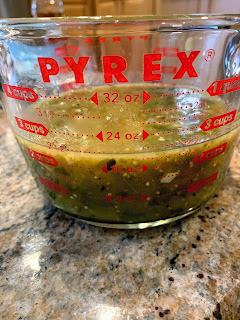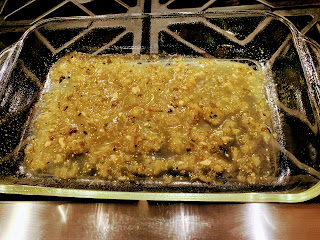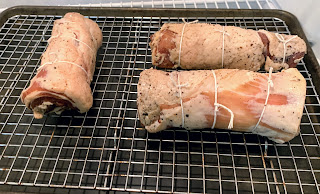Last week we got tomatillos in the box, and I've had jalapeños from the last two boxes, so it was time to make some salsa verde and enchiladas verdes.
The Enchiladas Verdes recipe is adapted from a
Cooking Light recipe from 1999. It's also great w/ leftover rotisserie chicken and a jar of your favorite tomatillo salsa instead making your own. It's easy to put together ahead of time, and makes good leftovers.
The salsa base is from Rick Bayless' Mexican Kitchen, and I've written about another tomatillo salsa from the
same book here. This is a simmered sauce, and one he recommends for enchiladas. I made a double batch and froze half for enchiladas later (because I might have still had tomatillos from last week's CSA box).
Essential Simmered Tomatillo-Serrano Sauce (CSA ingredients are marked w/ an *)
*1 pound tomatillos, husked and rinsed
*Fresh serrano chiles to taste (3, 1/2 oz total - I ended up subbing two of the jalepeños from the CSA, they weighed about 1 oz and I took the seeds out of one of them after roasting.
1 tbs olive oil
1 medium yellow onion (6 oz) roughly chopped
*2 large garlic cloves, peeled and roughly chopped
2 cups chicken stock (you could probably sub water here to make it vegetarian, but we're making chicken enchiladas so...)
1/3 cup roughly chopped cilantro.
1. Lay the tomatillos and chiles on a baking sheet and broil about 4" from the broiler for about 5 minutes a side. The tomatillos and chiles should start to soften and blacken. Transfer the vegetables and any accumulated juices to a blender or food processor.
2. Heat 1/2 tbs of the olive oil in a 5 qt dutch oven over medium heat. Add the onion and cook, stirring often, until deep golden, about 8 minutes. Add the garlic and cook and stir a minute longer. Scrape the mixture into the blender or food processor. If your using a blender, take out the "stopper" in the cover and cover loosely w/ a kitchen towel while blending to prevent a massive cleanup of your kitchen becoming necessary. Pulse the whatever your using a few times to reduce the vegetables to a rough puree.
3. Add 1/2 tbs of oil to the pot and heat over medium high. When it's hot enough to sizzle when a drop of puree is placed in it, pour all of the puree in and stir constantly for 4 or 5 minutes. The sauce base will reduce and become thicker and darker. Stirr in the broth, return to a boil, reduce the heat to medium and simmer briskly until thick enough to coat the back of spoon, about 10 minutes. Stir in cilantro and season to taste w/ salt.
Some pics!
The vegetables ready for their tan:
In the blender:
The "rough puree"
Final product, ready to go in the fridge to wait for enchilada assembly:
Enchiladas Verdes Adapted from Cooking Light
- 12 oz shredded cooked chicken (I usually use white meat, but whatever you like)
- 2 oz shredded asiago or asadero cheese (you could also substitute mexican shredded cheese blend if you can't find those)
- 1/3 cup finely chopped onion
- 1/3 cup finely chopped cilantro
- 1/3 cup chicken broth (If I'm fancy and have planned ahead, homemade, butI will use bullion here, or Better than Bullion)
- 1/3 cup low fat sour cream or greek yogurt
- 1 tbs fresh lime juice
- 1/2 tsp ground cumin
- 1/4 tsp salt
- 1/8 tsp black pepper
- 8-10 small corn tortillas
- 2 cups tomatillo salsa (a jar is fine if you don't want to mess with homemade, Harris Teeter has a good one)
- 1 oz shredded asiago or asadero cheese
- Mix together the first 10 ingredients to make the filling.
- Spray a 9"x13" baking dish with cooking spray, and pour 1/2 cup salsa in the bottom and tilt to coast the bottom of the dish.
- Heat each tortilla in a skillet or on a comal (I heat mine over a gas flame to get a little char), place the tortilla on a small plate, and scoop 1/3 cup filling down the middle of the tortilla, roll up and place seam side down. Repeat w/ remaining tortillas until you run out of filling.
- Pour remaining salsa over enchiladas.
- Sprinkle w/ remaining 1 oz cheese, cover w/ foil and bake at 400°F until thoroughly heated, about 20-30 minutes.
Some pics!
All the ingredients for the filling (some of the red onion from the CSA here!)
Salsa in the dish
First enchilada off the assembly line
All enchilada-ed!
Time for dinner




















































